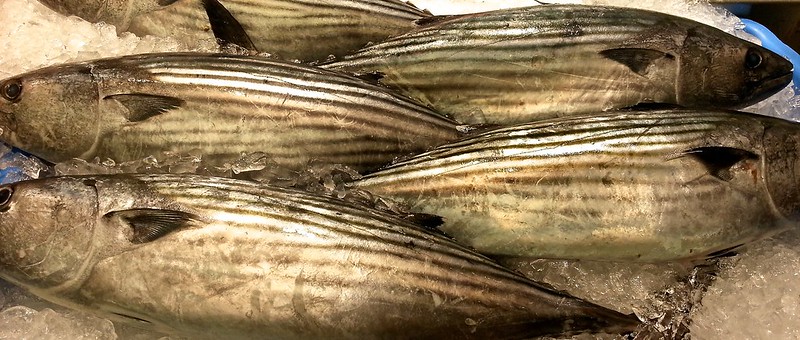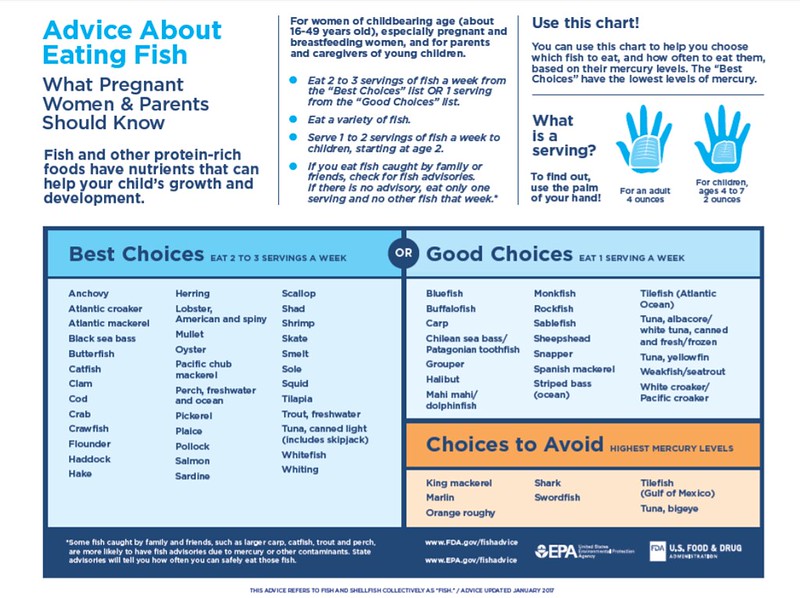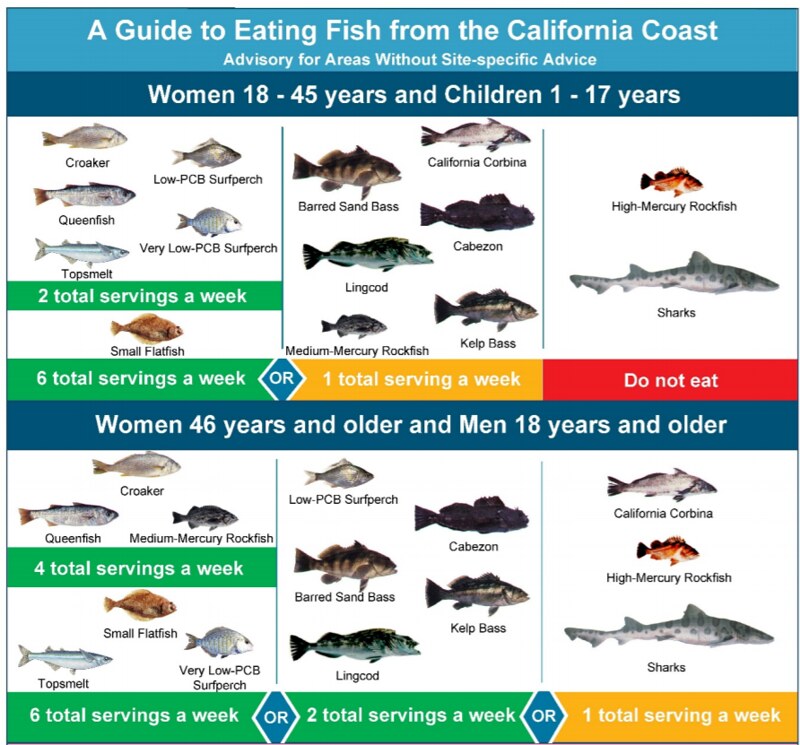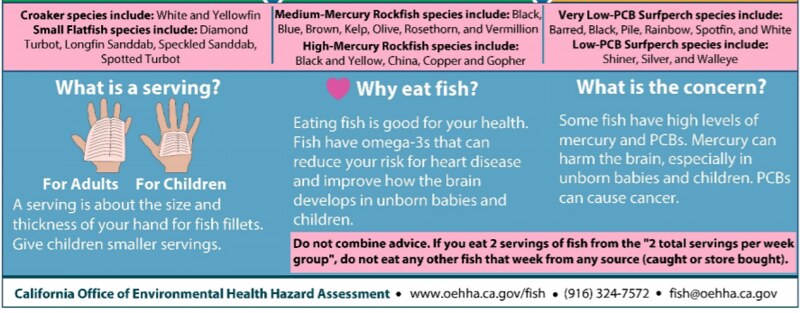Lian Guo OUR ECOSYSTEMS
seafood fish consumption advisories human health
Is it possible to eat too much fish?
Most people consider seafood to be a desirable and healthy food option. Who can resist a plate full of shrimp, salmon, or tuna!? Sure it’s expensive, but aren’t the taste and health benefits worth it? Good question.
Whether you buy seafood in restaurants or catch it yourself, it’s important to consider the health benefits and risks of what you are eating because it may affect you as well as your family. In particular, seafood is a source of proteins, unsaturated essential fatty acids, minerals, and vitamins that reduce potential cardiovascular or colon health risks associated with eating high amounts of red meat [1, 2]. Dietary guidelines in the U.S. recommend eating 8-12 oz of seafood per week (e.g. 2-3 palm-sized servings), but in 2015 Americans ate an average of 4.8 oz/week [3]. This suggests that Americans should be eating more seafood to be healthier.

Figure 1. Fish is a popular health food, but is it always healthy? (Source: llee_wu)
However, there’s another part of this health equation that isn’t usually considered by the average seafood consumer. If you eat seafood, you should also be aware of fish consumption advisories. Fish consumption advisories, or FCAs, give suggestions for how much seafood you should eat while accounting for the health risks of consuming seafood with contaminants or bacteria/viruses. One example of a contaminant that builds up in fish tissue is methylmercury. By eating fish, we directly take contaminants like methylmercury into our bodies, where it enters our tissues (our brain!). [The amount of methylmercury you eat decreases in your body by half every ~80 days; this slow rate of excretion leads to bioaccumulation, where mercury continues to build up as you eat more of it]. Most FCAs are concerned specifically with keeping methylmercury levels low enough to prevent negative health impacts.
It’s true that the omega-3s in fish tissue are beneficial, such that they can counteract the negative effects of methylmercury [2]. But there is still a balance to be maintained here. Certain fish, especially those that are higher in the food chain and/or longer-lived (tuna, swordfish, sharks) tend to accumulate more methylmercury in their tissues, to the point where it may outweigh the health benefits. When eating these fish, you are exposing yourself to more mercury.
So, how much fish should you eat to reduce your risk while maximizing health benefits? It really depends on the fish species and where it comes from. Federal government agencies, including the Environmental Protection Agency (EPA) and Food & Drug Administration (FDA), publish general advice about how much seafood is healthy to eat. Additionally, state governments test fish from local waters and issue fish consumption advisories for local fish. These consumption advisories are not perfect (I will address this in my next post), but they are helpful in making food choices that affect your health.
If you buy nonlocal fish…
…you should check the EPA/FDA recommendations for how often you should consume your fish of choice (Figure 2). There are some important elements to these consumption advisories that are not always clearly communicated.
Why does the advisory specify that reproductive women, pregnant women, and young children should have lower servings of fish? Neurodevelopment in fetuses and children is extremely sensitive to methylmercury, meaning even small doses of methylmercury can cause severe, lasting brain damage. This is why some advisories have separate advice for men compared to reproductive women and children.
Can I eat 2-3 servings of “best choices” in addition to 1 serving of “good choices” each week? It is best to think about your methylmercury consumption as a weekly budget. If you eat a “good choice” fish that you should only eat 1 serving of per week, you have used up your methylmercury budget for the week. It is safest to give your body some time to cycle out some of that mercury before eating more seafood. If you eat seafood on the “avoid” list, it may be best to wait weeks or months before consuming additional seafood, otherwise your mercury levels will continue to build up.

Figure 2. EPA/FDA general fish consumption guidelines for 2017. (Source: FDA)
If you eat local fish…
…you should check local fish consumption advisories for how often you should consume your fish of choice. You can google state-specific advisories; for example, type into google “California fish consumption advisories” (Figure 3). Depending on if your state borders the ocean, there should be both freshwater and marine fish consumption advisories.
How do local governments determine these fish consumption advisories? They catch and test fish tissue for contaminant levels. Typically, they use EPA/FDA standards for deciding how often that fish species should be eaten. Different states allocate different amounts of money to fish toxicology programs, meaning that the quality of data that the advisories are based on can range greatly.


Figure 3. An example of state-specific advice about California coastal fish. (Source: OEHHA)
No matter where your seafood comes from, it’s important to remember it can have good or bad effects on your health. Being aware of both means you can maintain good seafood eating practices for you and your family!
Note: This post is dedicated to Jeff Wenger, who was instrumental in helping me become a better writer and told me he would only read my blog post if I wrote about what seafood was safe for him to eat.
References:
[1] McAfee, Alison J., Emeir M. McSorley, Geraldine J. Cuskelly, Bruce W. Moss, Julie MW Wallace, Maxine P. Bonham, and Anna M. Fearon. “Red meat consumption: An overview of the risks and benefits.” Meat science 84, no. 1 (2010): 1-13.
[2] Sidhu, Kirpal S. “Health benefits and potential risks related to consumption of fish or fish oil.“ Regulatory Toxicology and Pharmacology 38, no. 3 (2003): 336-344.
[3] Ewald, John. “Americans added nearly 1 pound of seafood to their diet in 2015.” Americans added nearly 1 pound of seafood to their diet in 2015. National Oceanic and Atmospheric Administration. October 26, 2016. Accessed February 19, 2018. http://www.noaa.gov/media-release/americans-added-nearly-1-pound-of-seafood-to-their-diet-in-2015.
More From Thats Life [Science]
- La Belle et La Boeuf (NOT!) How do human meat preferences impact climate change?
- Artificial Selection: From Tiny Fish to Empty Dish
- A breath of fresh air: How the great oxygenation event changed life on Earth forever
- The Women Behind the Gun vs. The Women Behind the Bird
- How Community-based Conservation Helps Lemurs
- More ›
